I.Introduction
A. What is Human Morphology Catalog?
II. Datasets and Curation Model
A. Datasets
B. Curation model
III. Database Usage
A. What information is provided for HMC?
B. How to use HMC?
IV. Trait Description
A. Hair
B. Skin
C. Face morphology
V. Support
A. Comments & Collaborations
B. Contact us
I.Introduction
Human morphology, as one of the prominent complex traits of human beings, includes eye, skin, hair and other identifiable characteristics. Understanding its genetic mechanism is an essential question in human genetics, forensic genetics, and evolutionary genetics. As an increasing number of genome-wide association studies (GWAS) have identified numerous genotype-morphology associations, there is an urgent need to comprehensively extract these valuable associations from massive published literature and to make the information publicly available to the global scientific community.
With the aim of filling up the vacancy of single nucleotide polymorphism (SNP) data related to human morphological characters and providing publicly available resources on human morphology data, here we developed Human Morphology Catalog (HMC, https://ngdc.cncb.ac.cn/hmc), a web-based, open-access resource comprising over 1000 genes that are associated with human externally visual characteristics including craniofacial features, pigmentation of skin , properties of hair, etc. HMC features literature curation of 98 articles and accordingly houses a comprehensive collection of 225 morphology traits and 1158/3012 related genes/variants. For each trait, HMC provides detailed information including gene name, classified trait, SNP position, variation annotation, P value of GWAS and so on. Collectively, HMC, to our knowledge, is the first human morphology resource that incorporates a curated collection of genotype-morphology associations, and thus would be of great utility for a wide range of studies on forensic genomics and genetics of complex phenotypes.
II.Datasets and Curation Model
- genetic facial trait
- genetic hair trait
- genetic eye color or iris color trait
- genetic skin trait
With a manually semantic integration procedure, the externally visible traits and related genes and snps are hierarchically categorized.
The curation model we used is detailed below.
| Data type | Description | Value |
|---|---|---|
| Traits | Controlled vocabulary | Facial morphology; Hair; Limbs; Skin; Brain |
| Facial morphology | Feature classification | Allometry;Bizygomatic distance;Breadth of the nasal bridge nasion;Centroid size; Chin protrusion;Cleft palate;Columella inclination;Cutaneous lower lip height;Depth of the nasal alae;distance between eyeballs and nasion;Distance between the eyeballs; Facial height;Frontonasal dysplasia;Height of the vermilion upper lip;Incisor inclination; Inclination of mandibular incisor;Intercanthal width;Length of the philtrum;Lower lip height;Mandibular shapes;Mouth width;Nasion position;Nasion to midendocanthion;Neural crest lineage;Nose bridge breadth;Nose bridge width;Nose protrusion;Nose tip angle;Nose width;Nose wing breadth;Outer canthal width;Position of the mandibular;Subnasal width;Width of the cartilaginous portion of the nose |
| Hair | Feature classification | Baldness; Hair color; Hair Form(Hair curliness; Hair straightness) |
| Skin | Feature classification | Skin Property; Skin color |
| Limbs | Feature classification | Bilateral hyperphalangy leading to index finger clinodactyly; preaxial polydactyly of feet; Radial and tibial hypoplasia; Limb anomalies |
| Brain | Feature classification | Brain shape |
| Continent | Controlled vocabulary | Africa; South America;Noth America; Asia; Europe; Oceania |
| Population | Controlled vocabulary | Admixed South Americans; African Americans; Africans;Americans of European descent; Asian; Australian; Bantu African;Brazilian; Dutchman; East Asian; European American; European ancestry; German; Han Chinese ancestry; Indigenous Americans; Latin American; Melanesian; Polish; Uyghur Chinese ancestry; West African |
III. Database Usage
- SNP rs-ids
- Attribute of variant (reference allele, alternative allele, MAF)
- Nearby genes of the variant
- Related morphological traits
- The corresponding study population and provenance reference (PubMed ID, year of publication, title of paper)
1. Homepage:
In the homepage, HMC offers a fast and concise search function. In the quick search box, you can search for many items you interest in including:- Morphology trait name, e.g. Blue iris colour
- Gene name, e.g. KITLG
- SNP rsID, e.g. rs1805007
- Population, e.g. Asian
- Continent, e.g. Europe

2. Browse page:

The browse of morphology-related information is provided. For more details of human morphology traits, please click the items of the left Filters where 5 high-level classification shows above. Each classification includes many detailed classifications which you can choose to browse the associated genetic information.

You can also choose the kind of genetic information you interest in by click the items at the top bar including genes, SNPs and publications.

With clicking on the items like ‘genes- KITLG‘, there is a basic information page which shows the statistics and detailed information about specific genes you choose.
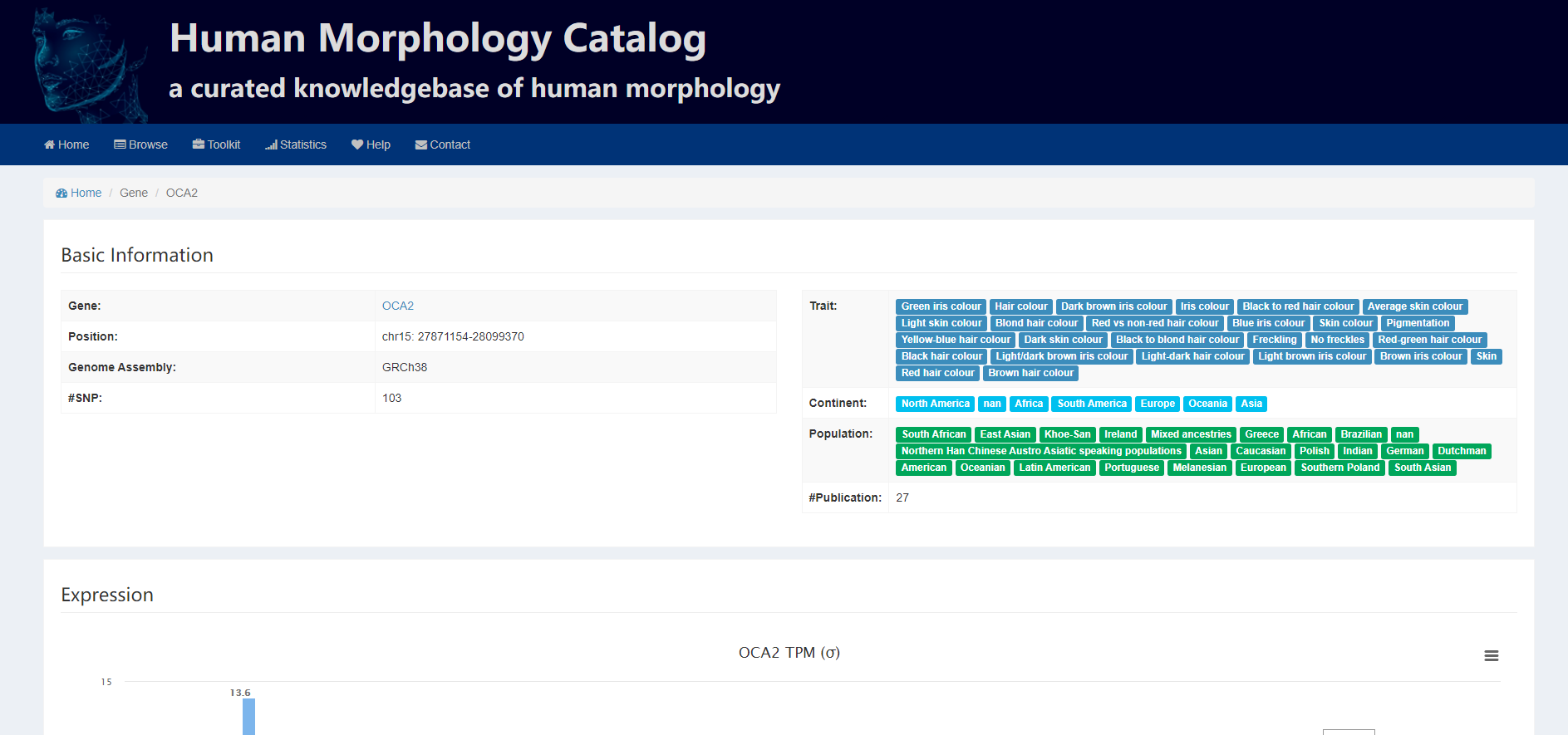
3. Toolkit page
We integrate an eye colour predicting tools in our database called ‘ Interactive macro for IrisPlex eye colour prediction modelling’. With the select of the numbers of eyecolour-related SNPs one have, the right table will show you the predicted results of the probability of different eye colours one may have.
With the development of genetics of human morphology and associated prediction work, we will aggregated more tools here to help the researchers to quickly get such information.

IV. Trait Description
1. Hair loss
Hair loss has long been a problem especially for man, which is known as alopecia or baldness. The most common type of hair loss is male-pattern alopecia, with men showing thinning hair on the forehead and top of the head, and women generally showing thinning hair and an upward movement of the hairline, but not 'baldness'. Genetic and hormonal factors are the main factors leading to androgyny, but poor living habits may also aggravate the symptoms.

2. Hair color
Hair color is determined by the amount of two types of melanin in hair follicle, including pheomelanin and eumelanin, and has a high diversity in different populations. In general, there are five basic hair colors including black, brown, blond, red and white with different color shade scale. Here, we list four types of hair color except white because it happens with aging, and make a detailed description of its distribution.

Black hair is caused by large amount of eumelanin and is the most common hair color. It can be found in all over the world except Northern European.
Brown hair is characterized by a moderate amount of eumelanin and a small amount of pheomelanin, which is the second common hair color. Brown hair is mainly distributed in Europe, America and Australia.
Blonde hair contains different types ranging from pale white to dark gold, the concentration of pheomelanin and eumelanin are changing accordingly, but both are in low level. Blonde hair is less common in the world and you can find them mostly in Northern Europe. Researchers believe that light hair color is linked to ultraviolet light, but some natives of Melanesia also exist people with blonde hair even though they live in areas with low latitude.
Red hair is very rare, and is caused by large amount of pheomelanin with a little eumelanin. It is most commonly found in Europe especially in British Isles. People with red hair are always accompanied by freckles, and found to have mutations in gene MC1R.
3. Hair texture (curl pattern)
Curl pattern is one of three main aspects of hair texture, Andre Walker system are widely used to classify hair and have four types of curl pattern corresponding to straight, wavy, curly and kinky hair. The mechanism of hair curl pattern has not been determined, but researchers think it may have to do with different hair follicles, and different cross-sectional shapes of hair have different levels of frizziness. Generally speaking, the straighter the hair, the rounder the cross section.

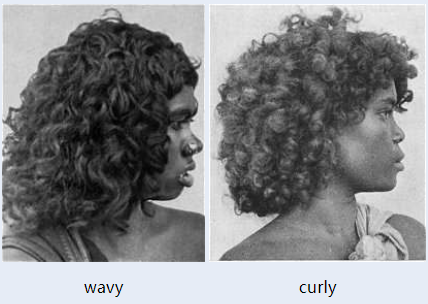
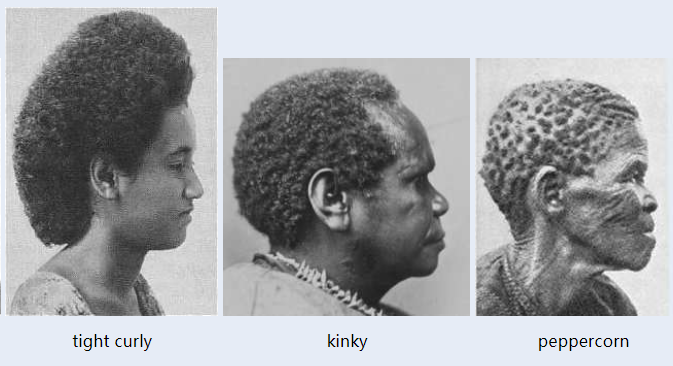

Intriguingly, different curl pattern of hair has a high correlation with areas. Asians always have straight hair while Europeans with wavy hair, and you can find curly and kinky hair mostly in Africa. Curl pattern is largely determined by genetic factors, but living environment, nutriture and other factors can also have a small effect on it.
Skin, the body's largest organ, plays a role in protection, regulation and perception. It is composed of epidermis, dermis and subcutaneous, with hair follicles, sweat glands and sebaceous glands as its appendixes. Skin phenotypes have long been the focus of attention, not only in biology, but also in culture to convey a lot of information.
Skin color is a well-studied phenotype which has a high diversity all over the world. It is related to melanin in epidermis and has a high correlation with latitude, which indicates the importance of ultraviolet in forming different skin colors. Dark skin is found in regions near to the equator where light skin is found in regions away from the equator. However, different skin color of regions in same latitude such as Africa and South America, the Arab region and south China, also indicates the non-negligible effect of environment on skin color variation.
Another skin phenotype related to pigmentation is freckle, which interestingly is always accompanied by red hair.

Human face plays an important role in social activities. The development of face is extremely complex, which is mainly derived from embryonic cranial neural crest cells. We describe the complexity of human face from local to global aspects. It includes nose, eyes, mouth, ears, eyebrows, forehead, chin, cheeks, different parts are combined to form a unique face. The size and shape of a person's face is also very impressive at first glance. Additionally, landmarks-based traits can also be used to describe facial variation, inner canthus, outer canthus, nose tip and nose alar are frequently used to calculate the distance and other parameters between these points.
1. Nostril models
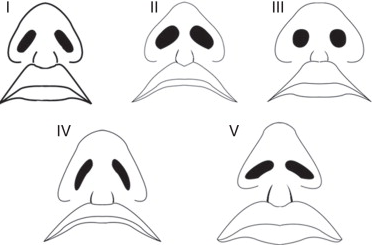
2. Nasal profiles

3. Categories of Severity in Sagging Eyelids

4. Malformation in Face
Apart from normal facial phenotypes, malformation in face have long been a problem, cleft lips and palates are a common disease which happens frequently in children. Although some genes were identified to be related, the underlying biological mechanisms have not been fully understood.
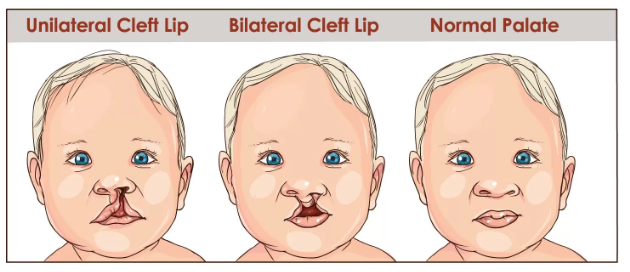
Variation of facial phenotypes in different populations are also very intuitive. Nasal index, the ratio of the nose to its height is commonly used in human anthropology to classify human nose, small nasal index indicates narrow and long nose which you can find in Europeans. Africans, on the other hand, tend to have flat noses with a higher index. Some researchers believe the differences may be related to temperature. The narrow and long nasal cavity can protect respiratory tract from cold air. Another phenotype, thicker lips of Africans, may also be related to thermoregulation duo to the high temperature and dry climate. Epicanthus, commonly known as Mongolian fold, is a fold of the skin inside the eye of the human upper eyelid, which is common in East Asia, Central Asia and native peoples of the Americas. These people had a thicker layer of fat around their eyeballs, and some researchers speculated that the phenotype might have evolved from a cold environment.